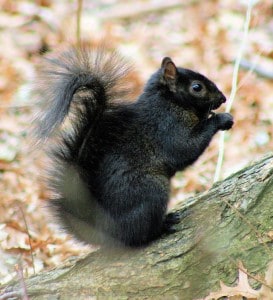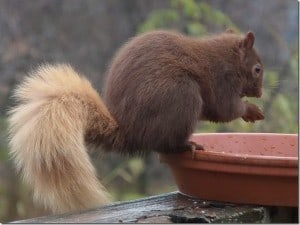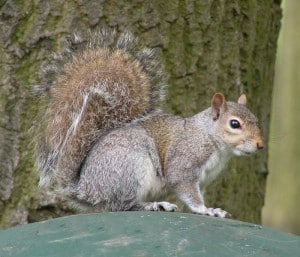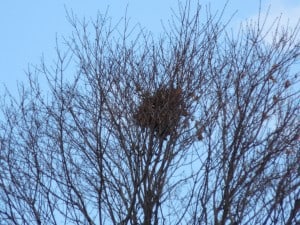Love them or hate them, nearly everyone has an opinion on Gray Squirrels. Maybe you are the type who adores these animals, feeds them and gives them silly names. On the other hand, you may fall into the camp of those who curse them for eating up the birdseed or digging up the tulip bulbs. Regardless of what you think of them, they are important indicators of the health of local ecosystems. If we have healthy squirrels, we can usually assume that we have healthy trees. Healthy trees, in turn, indicate a generally healthy environment, which of course is good for humans, too.
Description
The Gray Squirrel’s scientific name is Sciurus carolinensis. Sciurus is Greek for “shadow tail” and refers to the animal’s habit of sitting in the shade of its long, flat, bushy tail. The squirrel uses its tail both as a counterbalance and as a sort of parachute when jumping from tree to tree. As the common name denotes, these squirrels are predominantly grey in colour. Just like people, however, their “hair” colour can vary. In Peterborough, most Gray Squirrels are in fact black. This is not a separate species but rather a genetic variation known to scientists as a “colour morph.” Despite the predominance of black individuals, maybe 10 percent of our local squirrel population is indeed grey. There are also rare instances of a reddish or brownish colour morph, one of which was reported to me recently. You sometimes see combinations of different colours, too. There used to be a squirrel in our neighbourhood that was black with a red tail. Some squirrels also display patches of white. In Exeter, Ontario (50 km north of London), there is even a population of white Gray Squirrels. They are not albinos but are actually colored white or slightly off-white. They have normal colored eyes, unlike the classic red eyes of albinos.
Ecology
Gray Squirrels are essentially vegetarians, although they may sometimes eat insects or even the odd baby bird or egg. In the fall and winter, their favourite foods are wild fruits and seeds, including berries, acorns, walnuts and maple keys. Watch for them high up in Manitoba and Norway maples feeding on the keys. In the spring, their diet turns to tree buds, tree flowers and even Sugar Maple sap. During the summer months, squirrels eat fruits, berries, and succulent plant materials. They are also known to chew the bark from a variety of trees, although the exact reasons for this behaviour are poorly understood.
As anyone who feeds wild birds knows, Gray Squirrels also love sunflower seed, millet and suet cakes. They can provide great entertainment as they try to access a strategically-located feeder or one with a squirrel guard. About the only seeds they usually dislike are safflower seeds. These rodents also have the very annoying habit of digging up bulbs and either eating them or reburying them elsewhere.
Gray Squirrels are scatter-hoarders. This means that they hoard food in numerous small caches, scattered about a given area. Each food item is cached separately in a cup-shaped hole about one inch below ground. The hole is then covered with soil. Over the course of the fall, a single squirrel is estimated to make several thousand caches. In the more permanent caches, the food is not retrieved for weeks or months. Other caches, however, are only temporary and the squirrel may return only hours later and rebury the food item in a more permanent and secure location. If the squirrel senses it is being watched, it will sometimes only pretend to bury the food, all the while concealing the morsel in its mouth.
Gray Squirrels also have an amazing ability to retrieve the food they have hidden. Most importantly, they depend on very accurate spatial memory. This allows them to remember cache locations with respect to distant and nearby landmarks. For example, they may use the relative position of trees and buildings. They can then triangulate, relying on the angles and distances between these distant landmarks and their caches. Once the squirrel is close to the cache, a keen sense of smell helps it find the exact location. Accurate spatial memory is especially important in the winter when caches are often covered with snow and smells are hard to detect. Frequently, however, the food a squirrel finds may actually have been buried by another individual.
Not all hidden nuts are recovered. Some will germinate and grow into trees. This probably explains why you may suddenly find a walnut tree growing on your property, even though there are no mature walnut trees in the immediate area.
Reproduction
Gray Squirrels are able to breed twice a year, once in early spring and sometimes a second time in late summer. In years when wild food is scarce, however, they will only breed in the spring. Mating takes place in January or February, when the females come into heat and give off a scent that the males find irresistible. It is not uncommon to see a group of squirrels streaming by in a treetop chase as three or four males chase a half-terrorized female. Some amazing acrobatics are usually part of the show.
Tree cavities are the Gray Squirrel’s preferred nesting site. However, they will also construct a leafy nest in the fork of a large tree. Slightly larger than a basketball, the tree nests or “dreys” consist of an outer shell of leaves and twigs and a cozy inner chamber lined with mosses, grasses, shredded bark, and sometimes even cloth or paper. During cold winter weather, the dreys also provide shelter for the squirrels, and several individuals may snuggle up together. Dreys are most commonly seen in cities – probably because tree cavities are less common – and are especially evident near the tops of large maples. It is not uncommon to see five or six dreys in the same tree. It should also be noted that Gray Squirrels will also sometimes nest in the attic or exterior wall of a house.
Other behaviours
Here are some other interesting Gray Squirrel behaviours to watch and listen for:
• Leaping up trees; not climbing.
• Coming down a tree head-first, something very mammals are able to do. The squirrel achieves this by rotating its back paws 180 degrees, so that the claws are pointing up the tree instead of down. This allows the animal to firmly grip the tree bark.
• Using vocalizations and tail flicking to communicate. One of the most common sounds that Gray Squirrels make is a loud “kuk.” The sound is produced in conjunction with tail flicking and is used to ward off predators or warn other squirrels of a predator’s presence.
• Entering or exiting a drey. This is something I have yet to see myself. I would love to hear from anyone who witnesses this.
• Flattening out its body against a tree trunk or tree limb and remaining motionless. This is sometimes done in situations where danger threatens, but the squirrel decides against running away. Sometimes, a squirrel will also move inconspicuously around the trunk of the tree, keeping just out of sight of the predator or intruding human.
It is important not to take Gray Squirrels for granted or to demonize them. Because they are common in urban areas and are active during the day, squirrels are the wild mammals that many of us encounter most. The next time they visit your yard, take some time to really watch them. Encourage your children or grandchildren to do the same. Like everything in nature, they are far more fascinating than you might ever think.



